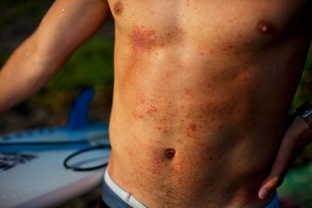Itching of the skin is the most common problem in dermatology, it is observed not only in patients with dermatoses, but also in patients with other general diseases. Itching of the skin affects the general condition and quality of life, causing anxiety, fear, insomnia, which sometimes lead to depression, and in severe cases, to suicidal thoughts.
In fact, there are a lot of common diseases that lead to itching of the skin. The doctor's task is difficult - to assess the cause of pruritus, given its features. What is itching? What is the mechanism of its development, and what diseases of the internal organs are the causes of skin itching, read on estet-portal.com.
What is itching? What is the mechanism of skin itch development?
Itching sensation refers to one of the skin analyzer's senses along with the sensation of pain and touch. Pain provokes the development of the effect of "removal" from the source of pain, and with itching, the “processing” reflex develops. In this case, any effect on the itchy area (pinching, scratching, tingling, kneading) leads to instant satisfaction, which quickly passes and is replaced by the same itching. Why is this happening?
The fact is that in the process of combing, impulses are modeled in the nerve endings of the skin, which are stronger. They inhibit the conduction of weaker itching impulses from skin lesions. Thus, the feeling of severe itching can be alleviated by causing severe damage, which leads to the replacement of the feeling of itching by pain. With prolonged presence of pruritus in the brain, a focus of excitation of a pathological nature is formed.
What internal pathologies provoke the development of pruritus?
Skin itching can be physiological and pathological. Physiological itching appears when irritated by environmental factors – temperature change, crawling insects. Pathological pruritus is caused by pathological changes in the whole body or only in the skin and causes a strong need for scratching.
Skin itching appears on altered skin as a symptom of various dermatoses (pediculosis, scabies, dermatitis, fungal infections, eczema, psoriasis, lichen) or appears on unchanged skin and is a symptom of internal disorders.
Internal causes of pruritus:
- Autoimmune diseases.
- Psycho-neurotic disorders and neurological diseases.
- Neoplasms of internal organs, melanomas.
- Blood pathologies (leukemia, mastocytosis, polycythemia vera, lymphogranulomatosis, iron deficiency anemia).
- Liver diseases (extrarenal cholestasis, biliary cirrhosis, hepatitis of various etiologies).
- Diseases of infectious and parasitic nature (helminthiases).
- Metabolic and endocrine disorders (menopause, hyperparathyroidism, hypothyroidism, hyperthyroidism, diabetes mellitus).
- Chronic renal failure.
- Senile itching due to old age.
- Pregnancy.
- Taking certain medications.

Effects of long-term pruritus
Against this background, pruritus from a protective reaction acquires the role of a standard skin reaction to various kinds of irritations. In addition, with prolonged combing, a change in the state of peripheral nerve receptors occurs. This leads to a decrease in the perception threshold for itching. This forms a "vicious circle" that is the cause of difficulties in the treatment of pruritus.
Itching occurs when unmyelinated nerve fibers are stimulated. Their free nerve endings are located on the border of the epidermis and dermis. Stimulation of nerve fibers can be thermal, mechanical, chemical and electrical. They excite nerve fibers directly or indirectly through the mediators histamine, neuropeptides, proteases or serotonin.
Therefore, the occurrence of itching requires immediate contact with a specialist for diagnosis and treatment. Knowing the mechanism of development of pruritus and the causes of its occurrence, it is easier to find an effective treatment.
How to diagnose the cause of itching at the site of localization, what additional research methods are required for diagnosis and what substances have antipruritic properties, read in our following articles.







Add a comment